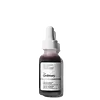What's inside
What's inside
 Key Ingredients
Key Ingredients

 Benefits
Benefits

 Concerns
Concerns

 Ingredients Side-by-side
Ingredients Side-by-side

Melaleuca Alternifolia Leaf Extract
PerfumingGlycerin
HumectantEthylhexyl Stearate
EmollientMethylpropanediol
SolventNiacinamide
SmoothingTrehalose
HumectantMethyl Trimethicone
Skin ConditioningCetearyl Glucoside
EmulsifyingSorbitan Olivate
Emulsifying1,2-Hexanediol
Skin ConditioningWater
Skin ConditioningCetearyl Alcohol
EmollientXanthan Gum
EmulsifyingCentella Asiatica Extract
CleansingFicus Carica Fruit Extract
HumectantEclipta Prostrata Leaf Extract
Skin ConditioningLaminaria Japonica Extract
Skin ProtectingGloiopeltis Furcata Extract
Skin ConditioningAllantoin
Skin ConditioningAloe Barbadensis Leaf Extract
EmollientAnthemis Nobilis Flower Extract
MaskingButylene Glycol
HumectantCamellia Sinensis Leaf Extract
AntimicrobialCarthamus Tinctorius Seed Oil
MaskingEthylhexylglycerin
Skin ConditioningGlycyrrhiza Glabra Rhizome/Root
EmollientHamamelis Virginiana Extract
AntiseborrhoeicMelaleuca Alternifolia Leaf Oil
AntioxidantAmaranthus Caudatus Seed Extract
Skin ConditioningUlmus Davidiana Root Extract
Skin ConditioningCinnamomum Zeylanicum Bark Extract
AntimicrobialPinus Pinaster Bark Extract
AntioxidantHydrogenated Lecithin
EmulsifyingSodium Polyacryloyldimethyl Taurate
Emulsion StabilisingSorbitan Stearate
EmulsifyingCaprylic/Capric Triglyceride
MaskingGlycine Soja Sterols
EmollientLinoleic Acid
CleansingPhospholipids
Skin ConditioningDisodium EDTA
Fructooligosaccharides
HumectantSalicylic Acid
MaskingBeta-Glucan
Skin ConditioningHydrolyzed Hyaluronic Acid
HumectantCapryloyl Glycine
CleansingCeramide NP
Skin ConditioningHexylene Glycol
EmulsifyingCamphor
MaskingSilica
AbrasiveSarcosine
Skin Conditioning4-Terpineol
MaskingMethyl Methacrylate Crosspolymer
Melaleuca Alternifolia Leaf Extract, Glycerin, Ethylhexyl Stearate, Methylpropanediol, Niacinamide, Trehalose, Methyl Trimethicone, Cetearyl Glucoside, Sorbitan Olivate, 1,2-Hexanediol, Water, Cetearyl Alcohol, Xanthan Gum, Centella Asiatica Extract, Ficus Carica Fruit Extract, Eclipta Prostrata Leaf Extract, Laminaria Japonica Extract, Gloiopeltis Furcata Extract, Allantoin, Aloe Barbadensis Leaf Extract, Anthemis Nobilis Flower Extract, Butylene Glycol, Camellia Sinensis Leaf Extract, Carthamus Tinctorius Seed Oil, Ethylhexylglycerin, Glycyrrhiza Glabra Rhizome/Root, Hamamelis Virginiana Extract, Melaleuca Alternifolia Leaf Oil, Amaranthus Caudatus Seed Extract, Ulmus Davidiana Root Extract, Cinnamomum Zeylanicum Bark Extract, Pinus Pinaster Bark Extract, Hydrogenated Lecithin, Sodium Polyacryloyldimethyl Taurate, Sorbitan Stearate, Caprylic/Capric Triglyceride, Glycine Soja Sterols, Linoleic Acid, Phospholipids, Disodium EDTA, Fructooligosaccharides, Salicylic Acid, Beta-Glucan, Hydrolyzed Hyaluronic Acid, Capryloyl Glycine, Ceramide NP, Hexylene Glycol, Camphor, Silica, Sarcosine, 4-Terpineol, Methyl Methacrylate Crosspolymer
Glycolic Acid
BufferingWater
Skin ConditioningAloe Barbadensis Leaf Water
MaskingSodium Hydroxide
BufferingDaucus Carota Sativa Extract
PerfumingPropanediol
SolventCocamidopropyl Dimethylamine
EmulsifyingSalicylic Acid
MaskingLactic Acid
BufferingTartaric Acid
BufferingCitric Acid
BufferingPanthenol
Skin ConditioningSodium Hyaluronate Crosspolymer
HumectantTasmannia Lanceolata Fruit/Leaf Extract
AntioxidantGlycerin
HumectantPentylene Glycol
Skin ConditioningXanthan Gum
EmulsifyingPolysorbate 20
EmulsifyingTrisodium Ethylenediamine Disuccinate
Potassium Sorbate
PreservativeSodium Benzoate
MaskingEthylhexylglycerin
Skin Conditioning1,2-Hexanediol
Skin ConditioningCaprylyl Glycol
EmollientGlycolic Acid, Water, Aloe Barbadensis Leaf Water, Sodium Hydroxide, Daucus Carota Sativa Extract, Propanediol, Cocamidopropyl Dimethylamine, Salicylic Acid, Lactic Acid, Tartaric Acid, Citric Acid, Panthenol, Sodium Hyaluronate Crosspolymer, Tasmannia Lanceolata Fruit/Leaf Extract, Glycerin, Pentylene Glycol, Xanthan Gum, Polysorbate 20, Trisodium Ethylenediamine Disuccinate, Potassium Sorbate, Sodium Benzoate, Ethylhexylglycerin, 1,2-Hexanediol, Caprylyl Glycol
 Reviews
Reviews

Ingredients Explained
These ingredients are found in both products.
Ingredients higher up in an ingredient list are typically present in a larger amount.
1,2-Hexanediol is a synthetic liquid and another multi-functional powerhouse.
It is a:
- Humectant, drawing moisture into the skin
- Emollient, helping to soften skin
- Solvent, dispersing and stabilizing formulas
- Preservative booster, enhancing the antimicrobial activity of other preservatives
Ethylhexylglycerin (we can't pronounce this either) is commonly used as a preservative and skin softener. It is derived from glyceryl.
You might see Ethylhexylglycerin often paired with other preservatives such as phenoxyethanol. Ethylhexylglycerin has been found to increase the effectiveness of these other preservatives.
Glycerin is already naturally found in your skin. It helps moisturize and protect your skin.
A study from 2016 found glycerin to be more effective as a humectant than AHAs and hyaluronic acid.
As a humectant, it helps the skin stay hydrated by pulling moisture to your skin. The low molecular weight of glycerin allows it to pull moisture into the deeper layers of your skin.
Hydrated skin improves your skin barrier; Your skin barrier helps protect against irritants and bacteria.
Glycerin has also been found to have antimicrobial and antiviral properties. Due to these properties, glycerin is often used in wound and burn treatments.
In cosmetics, glycerin is usually derived from plants such as soybean or palm. However, it can also be sourced from animals, such as tallow or animal fat.
This ingredient is organic, colorless, odorless, and non-toxic.
Glycerin is the name for this ingredient in American English. British English uses Glycerol/Glycerine.
Learn more about GlycerinSalicylic Acid (also known as beta hydroxy acid or BHA) is a well-known ingredient for treating skin that struggles with acne and clogged pores. It exfoliates both the skin's surface and deep within the pores to help clear out buildup, control oil, and reduce inflammation.
Unlike AHAs (alpha hydroxy acids), salicylic acid is oil-soluble. This allows it to penetrate into pores which makes it especially effective for treating blackheads and preventing future breakouts.
Salicylic acid is also known for its soothing properties. It has a similar structure to aspirin and can calm inflamed or irritated skin, making it a good option for acne-prone skin that is also sensitive.
Concentrations of 0.5-2% are recognized by the U.S. FDA as an over-the-counter topical acne product.
It can cause irritation and/or dryness if one's skin already has a compromised moisture barrier, so it's best to focus on repairing that before introducing this ingredient into your routine.
While salicylic acid does not increase sun sensitivity, it’s still important to wear sunscreen daily to protect your skin.
If you are looking for the ingredient called BHA or Butylated Hydroxyanisole, click here.
Learn more about Salicylic AcidWater. It's the most common cosmetic ingredient of all. You'll usually see it at the top of ingredient lists, meaning that it makes up the largest part of the product.
So why is it so popular? Water most often acts as a solvent - this means that it helps dissolve other ingredients into the formulation.
You'll also recognize water as that liquid we all need to stay alive. If you see this, drink a glass of water. Stay hydrated!
Learn more about WaterXanthan gum is used as a stabilizer and thickener within cosmetic products. It helps give products a sticky, thick feeling - preventing them from being too runny.
On the technical side of things, xanthan gum is a polysaccharide - a combination consisting of multiple sugar molecules bonded together.
Xanthan gum is a pretty common and great ingredient. It is a natural, non-toxic, non-irritating ingredient that is also commonly used in food products.
Learn more about Xanthan Gum